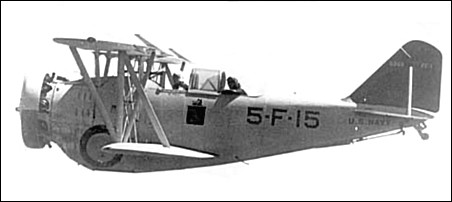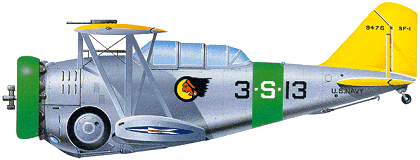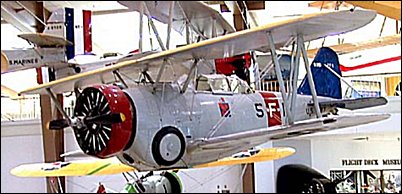 |
Grumman FF, SF1931 |  |
| CARRIER-BORNE FIGHTER, RECON | Virtual Aircraft Museum / USA / Grumman |
 |
In 1928 the US Navy aircraft carrier Langley participated in an exercise in which it made a surprise attack on the naval base of Pearl Harbor. The irony of this exercise aside, it proved two things: firstly that the US Navy appreciated that the base would be a prime target for any enemy during a major Pacific war; secondly that the aircraft carrier was one of the major offensive weapons of the future. As a result of this thinking USS Lexington and Saratoga were completed in 1927 and subsequently commissioned to bring the Navy's carrier force to three. In 1931 the XFF-1 prototype two-seat carrier-based biplane fighter flew for the first time. It was of advanced design with enclosed cockpits (the canopy made up of telescoping sections) and a landing gear that retracted into well-type recesses in the forward fuselage sides (almost identical with that used previously on the Dayton-Wright racing monoplane of 1920). During 1933 production FF-1s were delivered, each powered by a single 559kW Wright R-1820-78 radial engine, followed in 1934 by similar but R-1820-84-powered SF-1 scouts. FF-1s and SF-1s totalled 60 aircraft, sufficient to equip the Lexington. These remained on board until 1936, when they were replaced by F2Fs. Thereafter the fighters were converted into FF-2 dual-control trainers. In addition to US Navy aircraft, Turkey received 40 FF-1s and the RGAF 15 as Goblin 1s, all built by the Canadian Car and Foundry Company under licence. The Turkish fighters had by far the most interesting service life, being passed over to the Republican forces during the Spanish Civil War, with whom they fought for a time with other obsolete aircraft against well-equipped Nationalist forces. These were the only American-designed aircraft to fight in Spain. Another irony, only matched by that mentioned above, is that a single FF-1 was sold to Japan, a country that learned quickly the lessons in carrier operations taught throughout the inter-war period by unsuspecting nations.

|  COMPANY PROFILE | |||||||||||||||||||||||||||||||||||||||||||||||||||||||||
 |

|

